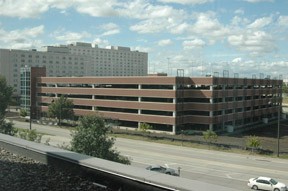
Parking at UNL has officially gone green.
After incorporating environmentally-friendly construction elements in other structures, UNL Parking and Transit Services has built a new parking garage designed to meet internationally-recognized green building standards.
"The new parking structure at 19th and Vine streets was an opportunity to really build in some sustainable measures," said Dan Carpenter, director of Parking and Transit Services. "Now complete, we believe the parking garage will pass the LEED silver standard."
The structure, located east of the Abel-Sandoz residence hall complex, has four levels with 1,040 parking spaces primarily for students.
The garage and a parking lot to the north are specially designed to better handle and make use of rainwater.
"We are testing a new product called pervious concrete on the parking lot itself," said Carpenter. "It's a product that, when rainwater hits the pavement, it doesn't just sit there. The water percolates through the concrete and into the soil."
Water that runs off the top deck of the parking structure drains directly into a landscaping area on the east side of the garage. And, drains from the other three decks funnel water into a specialized device that separates debris from the water.
"We are already using a hydrodynamic separator in the parking garage at 14th and Avery," said Carpenter. "It's basically a large storage tank that has a baffle designed to separate debris and pollutants from the water. The debris settles into the bottom of the tank, while the water continues into the storm water system."
For energy savings, the new parking structure uses a geothermal system to heat and cool a bus stop and stair towers. The ventilation system also uses wind and solar powered turbines. And, the entire structure makes use of LED lighting.
"We are going to see about a 35 percent savings in energy use in terms of the LED lighting alone," said Carpenter. "Roughly, we'll save about $17,500 per year using LED over incandescent lighting."
Sensors that detect activity and light levels further enhance the LED lighting system. During day hours, the sensors turn interior garage lights on and off depending on the amount of sunshine cascading into the structure. Then, in the evening, the lights dim to 50 percent when no movement is detected within a set period of time.
"The lights immediately turn back on when the motion detectors are tripped," said Carpenter.
Based on the projected cost savings, Carpenter said plans are being made to replace incandescent fixtures in UNL's other parking structures with LED lights.
As an additional energy-savings measure, lights in the garage will dim by half when no movement is detected within a set time.
The parking garage will even adopt a green hue on the south, east and west sides with the addition of specialized structures designed for climbing vines.
Designers are also looking for future cost savings, installing columns that could support photovoltaic (solar) panels on the upper deck. The panels would be able to supply enough energy to power the entire parking garage. Carpenter said, at this time, the panels are too expensive.
"But, we weren't thinking of installing heat pumps and other sustainable measures when we built Avery in 2004, and it certainly wasn't on our radar when we built the 17th and R garage in 2000," Carpenter said. "That's how quickly this technology has come along. We will watch and be ready to install the solar panels when the time is right."
Carpenter said the university is pursuing a LEED certificate from the federal sustainable building program. The LEED program - Leadership in Energy and Environmental Design - is a federal program developed by the U.S. Green Building Council intended to provide building owners and operators a framework for identifying and implementing practical and measurable green building design, construction, operations and maintenance solutions.
Along with the environmentally-friendly technology incorporated into the garage, the build itself also incorporated green measures, including concrete supplied by a plant less than a mile away from the site and brick panels made by a company in Lincoln. Carpenter said he believes the parking structure would merit a silver rating under the LEED specifications.
Carpenter said when UNL began planning the parking garage, there were two similar structures nationwide that had earned LEED certification. Today, there are five, one of which is at a university.
"Really, building a green parking garage is a new way of thinking. And it's pretty exciting to be a part of that," Carpenter said.
- Troy Fedderson, University Communications